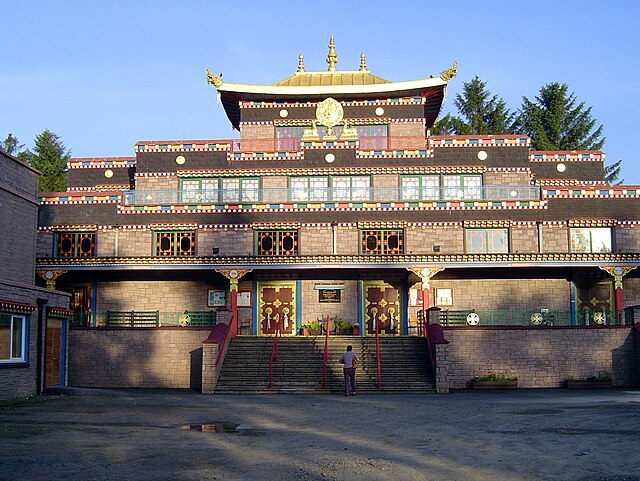Historical Context and Early Beginnings

Samye Ling traces its origins to 1967 in the rolling hills of southern Scotland. Originally, the site consisted of a 19th‐century building known as Johnstone House – a former hunting lodge – around which the early contemplative community took shape. Initially, this community was led by a Canadian Theravada monk named Anandabodhi. However, when the community began to decline, the trustees of Johnstone House sought new leadership and turned to Tibetan lamas who had come to the West as refugees. This invitation marked the turning point in the centre’s history, establishing the foundations of a Tibetan Buddhist presence on Scottish soil[2][5].
Founding Vision and Leadership
The transformative moment for the centre came when the trustees invited two eminent Tibetan lamas, Chögyam Trungpa Rinpoche and Akong Tulku Rinpoche, to take over in 1967. In a decisive act of reorientation, they renamed the centre Samye Ling – ‘Samye’ referring to the first Buddhist monastic university in Tibet and ‘Ling’ meaning ‘place’ – thus linking their new establishment with the historic spiritual lineage of Tibet[1][2][5][9]. They were soon joined by master‐artist Sherab Palden Beru and the monk Samten, whose contributions in traditional art and monastic practice helped infuse the centre with authentic Tibetan cultural expressions. Although Chögyam Trungpa Rinpoche played a significant role in the early period, his presence was relatively short-lived; by 1970 he had departed for America, leaving Akong Tulku Rinpoche to assume primary leadership. Under Akong’s guidance, the centre began a process of transformation that would not only widen its scope of teaching but also establish it as a major conduit for Tibetan Buddhist teachings in the West[1][2][5][9].
Growth and Expansion
Once firmly established under Tibetan guidance, Samye Ling quickly earned recognition as the foremost Tibetan Buddhist centre in Europe. During the early seventies, the arrival of other eminent Tibetan teachers — including visits by Kalu Rinpoche, Khamtrul Rinpoche, and others — helped bolster its reputation as a hub of authentic Buddhist practice. The centre’s transformation was not limited to curriculum expansion; significant construction projects began to take shape as well. The community, motivated by deep spiritual commitment, undertook the construction of a traditional Buddhist temple. This temple infuses the site with ancient ritual significance and serves not only as a place for meditation and public prayer but also as an artistic canvas adorned by the skilled handiwork of Sherab Palden Beru and his pupils[1][6][8]. Even as the centre grew, it retained its focus on serving both resident practitioners and international visitors. Its reputation for a combination of rigorous meditation practice and the preservation of Tibetan art, crafts, and cultural traditions helped to cement its status in the West. This period of growth also saw visits by renowned figures, including the legendary musicians David Bowie and Leonard Cohen, adding a layer of modern cultural intersection to the centre’s longstanding spiritual mission[2][4][3].
Legacy and Cultural Impact
Today, Samye Ling stands as a landmark institution in the transmission of Tibetan Buddhism beyond its traditional homelands. Its founding by Akong Tulku Rinpoche and the early contributions of Chögyam Trungpa Rinpoche have ensured that the teachings, art, and humanitarian work inspired by Tibetan Buddhism remain vibrant in a Western context. Over the decades, the centre has evolved into a fully functioning monastery, retreat centre, and cultural institute dedicated to preserving Tibetan religion, culture, medicine, art, architecture, and handicrafts. Facilities have continually expanded and now include a temple complex, accommodation blocks for longer stays, and specialized spaces for meditation, lectures, and artistic pursuits[1][6][7][11].
Moreover, under the later spiritual direction of Lama Yeshe Losal Rinpoche, the centre has maintained a focus on community building and social responsibility, always reflecting the fundamental Buddhist values of non-violence, compassion, and the encouragement to serve others. Recognized as the first Tibetan Buddhist centre in the West, Samye Ling has not only influenced spiritual practice but has also contributed significantly to the cultural dialogue between East and West. Its ongoing projects, including the creation of prayer wheels and the restoration of thangkas, ensure that the ancient teachings of Buddhism continue to be accessible while fostering an intercultural exchange of ideas and artistic traditions[1][2][5][10][11].
Get more accurate answers with Super Pandi, upload files, personalized discovery feed, save searches and contribute to the PandiPedia.
Let's look at alternatives:
- Modify the query.
- Start a new thread.
- Remove sources (if manually added).



